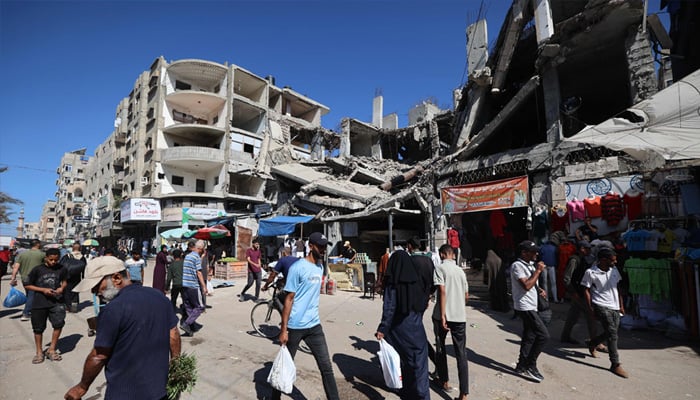As a precarious ceasefire remains in effect, displaced residents of Gaza City are coming back to their neighborhoods, only to discover their homes destroyed and many compelled to seek refuge in temporary shelters.
In the city’s northwest, deserted streets are flanked by mounds of concrete, the remnants of apartment blocks demolished during the Israel-Hamas conflict, with some buildings entirely flattened.
Hossam Majed, 31, found his home completely demolished. From within the wreckage, he managed to recover a few possessions, including some furniture and a large water tank—a critical find given the severe shortages.
As he awaits the return of his family, he has cleared away some debris, erected a provisional shelter, and resolved to protect what little remains from potential looting.
“Even food is more expensive here than in the south because it’s so scarce. We have no electricity, no water, and no internet. I have to walk a kilometer and a half just to fill two water containers,” he stated to AFP.
Umm Rami Lubbad had relocated to Khan Yunis in southern Gaza for safety last month as Israel intensified its offensive on Gaza City, aiming to dismantle Hamas, the group resisting illegal Israeli occupation.
She had clung to the hope of returning to her home, seeing it as “the last remaining chance for a semblance of stability.”
However, upon arriving back, the mother, along with her young child and two teenage daughters, was met with shock.
“My heart almost stopped when I saw the house was just rubble,” she told AFP, adding, “I looked as far as I could see—and saw nothing.”
The Lubbad family is now without a home.
“We are essentially sleeping in the open. I don’t have a tent,” she said, noting that neighbors provided shelter when artillery fire made staying outside too perilous.
She and her children have collected wood, clothing, and a gas canister, hoping to use the wood for cooking or to construct makeshift latrines.
“Life is unbearably difficult. I don’t know how long we can last,” she expressed.
She holds onto hope that tents will eventually be permitted into Gaza, which is subjected to a stringent Israeli blockade.
Ahmad al-Abbasi, who had fled south during the aerial bombardments, came back to find his five-story building in Gaza City utterly gone.
“We returned north hoping to find our homes and rebuild our lives. But as you can see… Gaza has become a ghost town,” he remarked.
In front of the ruins, he has tried to set up a rudimentary tent next to a Palestinian flag flying from a pole.
He has piled up cinder blocks to secure iron rods that hold up a sheet acting as a roof.
Although the structure stands, the wind whips against the fabric and the flag, creating a loud flapping noise.
“We are trying to save whatever we can. We will attempt to fix even a single room or put up one tent to shelter ourselves, our children, and our families,” he told AFP.
Another Palestinian, Mustafa Mahram, also returned to Gaza City to find his three-story house completely destroyed.
“Everything is lost, turned to ashes… Life here is impossible,” he mourned.
Mahram has pitched a tent near the debris of his former home and feels his family has been “cast out into the street.”
“There is no water—no drinking water, not even salty water, nothing at all,” he said.
“None of life’s basic necessities are here—no food, nothing to drink, nothing. And as you see, there’s nothing left but ruins.”














